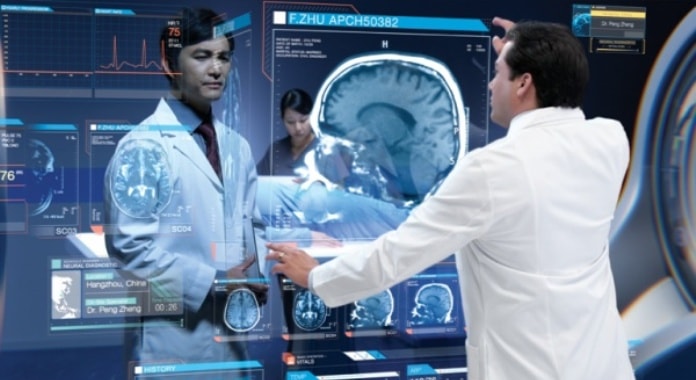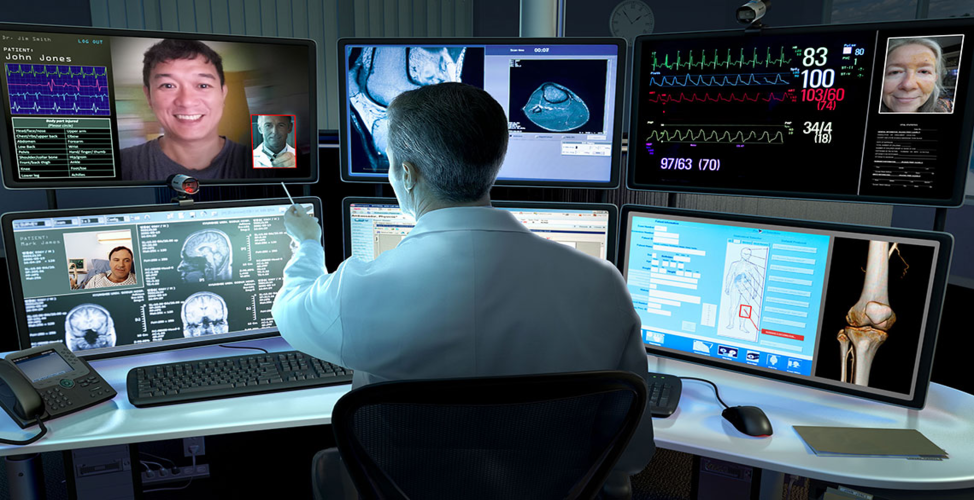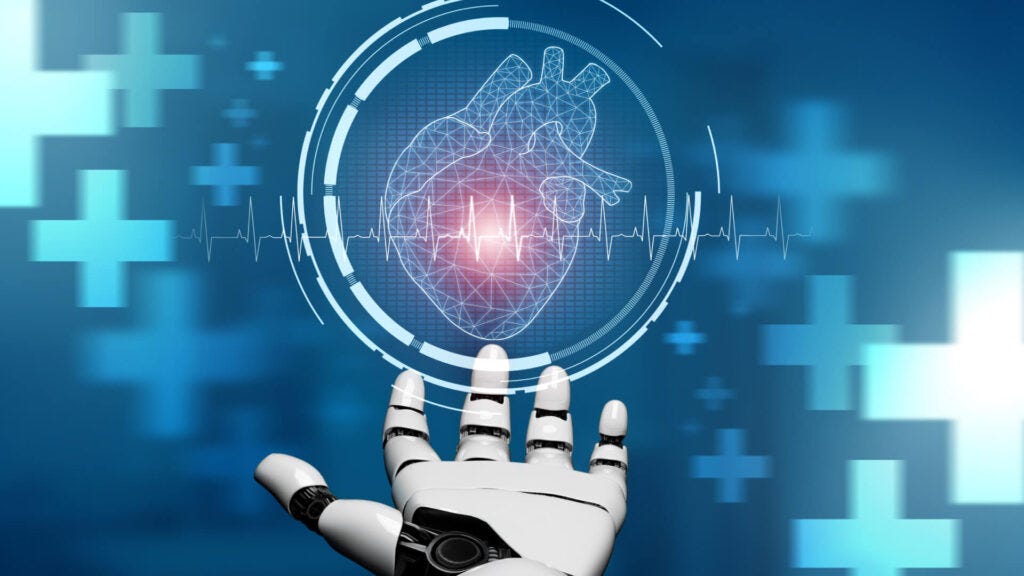Table of Contents
Introduction:
Artificial Intelligence (AI) and telemedicine are no longer just buzzwords in the healthcare industry. Together, they are at the forefront of revolutionizing how healthcare is delivered, making it more accessible, accurate, and efficient. With the rise of digital health, AI’s integration into telemedicine has empowered patients and medical professionals alike, leading to significant transformations in care delivery. This blog explores seven key impacts AI and telemedicine have made on modern healthcare, driving change and creating a new era of patient-centered care.

1. Enhanced Patient Diagnostics
AI algorithms have significantly improved diagnostic accuracy by leveraging advanced machine learning techniques to process and analyze vast amounts of medical data, including radiology scans, lab results, electronic health records (EHRs), and patient histories. Unlike traditional diagnostic methods that rely heavily on human interpretation, AI can rapidly sift through large, complex datasets to identify patterns, anomalies, and correlations that might not be immediately obvious to healthcare providers. This deep analysis enables AI to pinpoint potential health issues, such as tumors, cardiovascular problems, or neurological disorders, with greater precision and speed.
In radiology, for example, AI-powered image recognition systems can examine X-rays, CT scans, and MRIs to detect even the smallest anomalies, such as early-stage tumors or minute fractures, that could be easily overlooked by the human eye. These AI tools are trained on millions of images, allowing them to learn what constitutes a normal scan versus one that indicates a potential health concern. As a result, radiologists receive AI-assisted reports that highlight areas of concern, enabling them to focus on critical findings and make more informed decisions in a shorter time frame.
Beyond image analysis, AI’s capabilities extend to interpreting lab results and genetic data. AI algorithms can analyze biomarkers from blood tests`, for instance, to predict the likelihood of chronic conditions like diabetes or heart disease. In some cases, AI can even recommend additional tests or diagnostic procedures based on the patient’s unique data profile. This not only speeds up the diagnostic process but also ensures that patients receive timely and accurate information, allowing for early intervention when necessary.
Telemedicine platforms that integrate AI further enhance diagnostic efficiency. Healthcare professionals can remotely access AI-generated insights during virtual consultations, providing real-time diagnostic support. For patients in rural or underserved areas, where access to specialists may be limited, AI-driven telemedicine ensures they still receive high-quality diagnostic care. In this context, AI can act as a virtual assistant to healthcare providers, offering evidence-based suggestions on potential diagnoses and treatment pathways.
AI’s ability to detect anomalies earlier than traditional diagnostic methods has a direct impact on patient outcomes. Early diagnosis is often the key to successful treatment, especially in conditions like cancer, where early-stage detection can significantly improve survival rates. By identifying diseases before they progress, AI enables healthcare professionals to initiate treatment sooner, which not only improves the chances of recovery but also reduces the overall burden on healthcare systems by minimizing the need for extensive and costly treatments down the line.
Moreover, AI-based diagnostics reduce human error, which can occur due to fatigue, cognitive bias, or the sheer volume of data that healthcare providers must process. By serving as an analytical aid, AI reduces the risk of misdiagnosis and ensures that medical decisions are backed by comprehensive, data-driven insights. This collaborative approach between AI and healthcare professionals ultimately leads to more accurate, efficient, and personalized care for patients.
In summary, AI algorithms have transformed the diagnostic landscape by improving accuracy, speeding up processes, and enhancing the ability to detect conditions at earlier stages. When integrated with telemedicine, these advancements make healthcare more accessible and equitable, ensuring that patients receive timely and effective diagnoses, regardless of their geographical location.
Impact:
- Early detection of diseases like cancer.
- Improved accuracy in diagnosing chronic conditions such as diabetes and heart disease.
- Support for physicians with decision-making tools based on data-driven insights.

2. Personalized Treatment Plans
One of the most transformative aspects of AI in healthcare is its ability to generate highly personalized treatment plans for patients. Unlike traditional approaches that often rely on standardized treatment protocols, AI systems can analyze a vast range of individual patient data—including genetics, lifestyle choices, medical history, and even social determinants of health—to craft customized strategies tailored to each patient’s unique needs.
AI uses machine learning models to sift through complex data points and detect patterns that may not be immediately apparent to human clinicians. For example, AI can analyze genetic profiles to identify how a patient might respond to specific medications, a concept known as pharmacogenomics. This helps healthcare providers select the most effective drug treatments while minimizing the risk of adverse reactions. In cases of cancer, AI-driven genomic analysis can reveal the genetic mutations driving the disease, enabling doctors to prescribe targeted therapies that are far more effective than traditional chemotherapy.
Lifestyle factors, such as diet, exercise, and sleep patterns, are also considered by AI when creating treatment plans. For instance, AI might recommend personalized interventions for patients managing chronic conditions like diabetes or hypertension by analyzing their daily habits. By taking into account not only clinical data but also behavioral and environmental factors, AI can suggest adjustments in medication, diet, and physical activity to achieve better health outcomes. Patients are provided with highly specific guidance, which could range from adjusting insulin dosages based on real-time glucose monitoring to offering tailored dietary recommendations for weight management.
In telemedicine, this process becomes even more dynamic and accessible. Patients no longer need to visit a physical clinic to receive expert treatment advice; instead, AI can offer real-time recommendations through virtual platforms. During a telemedicine consultation, healthcare providers can access AI-powered insights that take into account the patient’s current health metrics, medical history, and real-time data from wearables or home monitoring devices. For example, an AI system might analyze a patient’s recent blood pressure readings and recommend changes to their medication dosage or lifestyle, all while the patient interacts with their doctor virtually.
This real-time personalization is particularly valuable for managing chronic diseases that require continuous monitoring and frequent adjustments to treatment. AI can track changes in the patient’s condition over time, predicting potential complications before they arise. For instance, AI-driven predictive analytics can alert both the patient and healthcare provider when a person with congestive heart failure is at risk of a worsening condition, prompting preemptive care adjustments that could prevent hospitalization.
Moreover, AI’s ability to personalize care doesn’t just stop at physical health—it extends into mental health as well. AI-driven platforms can analyze data from patient-reported outcomes, mood assessments, and behavior patterns to recommend personalized mental health treatments. Whether it’s suggesting tailored therapy sessions or adjusting medication for depression or anxiety, AI ensures that the treatment strategy fits the patient’s psychological profile.
Another significant benefit of personalized treatment plans generated by AI is improved patient adherence. When patients receive a care plan that is specifically designed for them—one that accounts for their personal preferences, health goals, and lifestyle—they are more likely to follow through with it. AI can further support adherence by sending reminders, providing educational content, and tracking progress in real-time, all through telemedicine apps. This increased engagement leads to better long-term health outcomes and reduces the likelihood of complications or disease progression.
In addition to improving patient outcomes, personalized AI-driven treatment plans also streamline the decision-making process for healthcare providers. Doctors and clinicians no longer have to manually analyze all available patient data to determine the best course of action. Instead, AI assists by providing evidence-based recommendations, saving time while ensuring that decisions are informed by the most comprehensive and up-to-date information available. This not only increases efficiency in healthcare delivery but also reduces the cognitive load on clinicians, allowing them to focus on patient interaction and care.
In summary, the integration of AI into personalized treatment planning represents a major leap forward in patient care. By analyzing individual patient data—ranging from genetics to lifestyle—AI can recommend treatments that are tailored to the unique needs of each patient. When combined with telemedicine, these personalized recommendations are delivered in real-time, making high-quality, individualized care accessible from the comfort of a patient’s home. This approach improves outcomes, enhances patient satisfaction, and sets a new standard for healthcare in the digital age.
Impact:
- Personalized care that considers the patient’s unique biology.
- Enhanced teleconsultations with AI-driven insights.
- Improved patient adherence to treatments due to customized healthcare plans.

3. Remote Monitoring and Predictive Analytics
AI in telemedicine enables continuous remote patient monitoring through wearable devices and apps that track vital signs, physical activity, and even mental health. This data is then analyzed using predictive analytics to foresee potential health issues. For example, AI can detect patterns that suggest an impending heart attack or stroke, allowing for proactive intervention.
Impact:
- Prevention of life-threatening events with predictive insights.
- Reduced hospital readmissions due to real-time monitoring.
- Enhanced chronic disease management through early detection.
4. AI-Driven Virtual Health Assistants
Virtual health assistants powered by AI are increasingly becoming part of telemedicine platforms. These assistants can handle routine tasks such as scheduling appointments, answering health queries, and even providing basic care advice. They are available 24/7, improving patient engagement and easing the burden on healthcare providers.
Impact:
- Enhanced patient engagement with round-the-clock support.
- Streamlined administrative processes, saving time for healthcare staff.
- Increased patient satisfaction due to immediate responses to health-related queries.

5. Optimized Resource Allocation
Optimizing Healthcare Resources with AI and Telemedicine
Artificial Intelligence (AI) is transforming how healthcare providers manage resources, making operations more efficient and cost-effective. By integrating AI with telemedicine systems, healthcare facilities can optimize staffing, resource allocation, and treatment strategies, leading to improved patient care and reduced operational costs.
Predicting Patient Inflow
One of the key benefits of AI in healthcare management is its ability to predict patient inflow. AI algorithms analyze historical patient data, including appointment schedules, emergency room visits, and seasonal trends, to forecast future patient volumes. This predictive capability allows hospitals and clinics to anticipate peak times and adjust staffing levels accordingly.
For instance, AI can predict higher patient volumes during flu season or identify trends in emergency room visits that correlate with specific events or weather conditions. With this information, healthcare administrators can schedule additional staff during peak times and ensure that essential resources, such as medical supplies and equipment, are adequately stocked. This proactive approach helps to prevent bottlenecks and reduces patient wait times, enhancing the overall patient experience.
Optimizing Staff Allocation
AI’s predictive insights also aid in optimizing staff allocation. By analyzing data on patient flow and care needs, AI systems can recommend how to best distribute healthcare professionals across different departments and shifts. For example, AI can identify patterns in patient visits to the emergency department and suggest when to deploy more nurses or specialists. This ensures that healthcare facilities have the right mix of staff available to meet patient needs without overstaffing or understaffing.
Moreover, AI can assist in identifying staff members’ strengths and areas of expertise, allowing for more effective team composition. For instance, if a hospital sees a rise in complex surgical cases, AI can recommend allocating more experienced surgeons to these cases based on their past performance and specialization. This targeted staff allocation improves the quality of care and enhances operational efficiency.
Reducing Unnecessary Procedures
AI-driven telemedicine systems can analyze patient data and clinical guidelines to recommend the most effective treatments for individual cases. By leveraging vast databases of medical knowledge and historical treatment outcomes, AI can suggest evidence-based treatment plans tailored to each patient’s condition. This reduces the likelihood of unnecessary tests or procedures that may not contribute to better outcomes.
For example, an AI system might analyze a patient’s symptoms, medical history, and test results to recommend a specific diagnostic approach. By avoiding redundant tests and focusing on targeted diagnostics, healthcare providers can streamline the diagnostic process and minimize patient discomfort and anxiety. Additionally, AI can help in determining the most cost-effective treatments, ensuring that patients receive appropriate care without incurring unnecessary expenses.
Enhancing Resource Utilization
AI can also optimize the utilization of healthcare resources, such as medical equipment and facilities. By analyzing usage patterns and patient needs, AI can recommend how to allocate resources more efficiently. For instance, AI systems can track the utilization of MRI machines or operating rooms and suggest scheduling adjustments to maximize their use. This helps in avoiding downtime and ensuring that critical resources are available when needed.
Furthermore, AI can assist in managing inventory levels of medical supplies and pharmaceuticals. By analyzing usage data and predicting future needs, AI systems can help healthcare facilities maintain optimal inventory levels, reducing waste and ensuring that essential supplies are always on hand.
Cost Reduction
The efficiencies gained through AI-driven resource management directly contribute to cost reduction. By optimizing staffing, reducing unnecessary procedures, and improving resource utilization, healthcare facilities can lower operational costs. These savings can be reinvested into improving patient care and expanding services.
For example, a hospital that uses AI to predict patient inflow and optimize staffing might reduce overtime expenses and avoid the costs associated with overstaffing. Similarly, by reducing unnecessary tests and procedures, healthcare providers can lower overall treatment costs, benefiting both patients and the healthcare system.
Future Directions
As AI technology continues to advance, its role in optimizing healthcare resources will expand. Innovations in machine learning, data analytics, and real-time monitoring will further enhance the ability of healthcare facilities to manage resources efficiently. Future developments may include even more sophisticated predictive models, better integration with electronic health records, and advanced tools for resource planning and allocation.
In summary, AI is revolutionizing resource management in healthcare by predicting patient inflow, optimizing staff allocation, reducing unnecessary procedures, and enhancing resource utilization. These advancements lead to improved efficiency, reduced costs, and better patient care, demonstrating the transformative impact of AI in modern healthcare management.
Impact:
- Better hospital and clinic resource management.
- Reduced patient wait times due to efficient staff scheduling.
- Cost savings for healthcare providers and patients.

6. Mental Health Support Through AI
Telemedicine has greatly expanded access to mental health services, and AI is now playing a key role in enhancing this aspect of care. AI-powered platforms can provide virtual therapy sessions, assess patient mental health through speech and behavior patterns, and offer personalized mental health interventions. These tools provide valuable support for patients, especially those in remote areas.
Impact:
- Increased access to mental health services.
- Personalized mental health care based on AI assessments.
- Reduction in stigma associated with seeking help for mental health issues.
7. Telemedicine and AI in Emergency Care
AI is playing a pivotal role in emergency care, especially in telemedicine consultations. During emergencies, AI systems can analyze patient data to prioritize cases based on severity. It can also guide healthcare professionals on optimal treatment strategies. For example, in the case of stroke patients, AI can analyze brain scans and suggest the most effective course of action, thereby reducing treatment time and improving outcomes.
Impact:
- Faster, more accurate emergency care decisions.
- Reduced mortality rates in critical conditions like strokes and heart attacks.
- AI-based triage systems that prioritize patient care based on urgency.
Conclusion:
The integration of AI into telemedicine has brought about a paradigm shift in healthcare, making it more patient-centered, efficient, and data-driven. From enhancing diagnostic accuracy to optimizing emergency care, AI and telemedicine are delivering better health outcomes and transforming how healthcare is accessed and delivered. As technology continues to evolve, the future of healthcare will increasingly rely on these innovations, ultimately benefiting patients, healthcare providers, and the entire healthcare system.
What is the transformative power of AI in healthcare?
AI’s transformative power in healthcare lies in its ability to analyze vast amounts of medical data to provide faster and more accurate diagnoses, predict patient outcomes, and offer personalized treatment plans. This has revolutionized how patients receive care, enhancing efficiency and improving overall health outcomes.
How has AI transformed healthcare?
AI has transformed healthcare by automating routine tasks, enhancing diagnostic accuracy, and providing predictive analytics for better patient management. It has streamlined healthcare operations, improved patient outcomes, and made healthcare more accessible through telemedicine platforms.
What is the impact of artificial intelligence in healthcare?
AI has had a profound impact on healthcare by improving diagnostic precision, enabling personalized treatment, reducing hospital readmissions through predictive analytics, and expanding access to mental health and emergency services. Its integration into telemedicine has made healthcare more efficient and patient-centered.